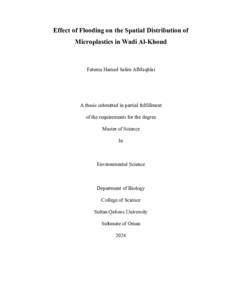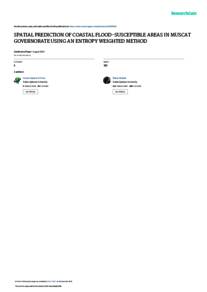وثيقة
Effect of flooding on the spatial distribution of microplastics in Wadi Al-Khoud.
المصدر
Master's thesis
عناوين أخرى
تأثير الفيضانات على التوزيع المكاني للميكروبلاستيك في وادي الخوض.
الدولة
Oman
مكان النشر
Muscat
الناشر
Sultan Qaboos University.
ميلادي
2024
اللغة
الأنجليزية
نوع الرسالة الجامعية
Master's thesis
الملخص الإنجليزي
Microplastics (MPs) are emerging pollutants that pose a significant threat to human health and the environment. Sediments are the main sink for MPs, but there is still much to learn about the factors affecting the distribution of MPs in the sediment. This study aims to investigate the effect of flooding on the spatial distribution of MPs in Wadi Al-Khoud and examine the impact of physiochemical features and human activities on the distribution and abundance of MPs.
Sediment samples were collected from 11 sites along the Wadi, including the upstream, midstream, and downstream of the Wadi. The sites were also categorized into five distinctive areas with one or more human activities/land uses. The collected samples were dried and sieved using a 2 mm sieve. Oxidation treatment was applied to remove the organic content using Fenton’s reagent, followed by density separation using a saturated sodium chloride solution. A Stereomicroscope was used for the physical identification of MPs properties and counting, while micro-Fourier Transform Infrared Spectroscopy (µ-FTIR) was used for chemical identification. Risk assessment was performed using the pollution load index (PLI) and polymer risk index (PRI) based on identified MPs' concentration and chemical toxicity.
Overall, the average concentration of MPs increased from 194.4 ± 53.3 -2083.3± 218.5 particles/ kg before the rain to 233.3± 27.2 -13166.7± 365.1 particles/kg after the rain, suggesting that MPs in the surrounding watershed washed into the Wadi stream. Flooding also affected the types of MPs, affecting the relative abundance of different shapes, sizes, and colors found in the samples. In both seasons, most common shape was fragments, followed by fibers, while most MPs were between 10-50 µm. The dominant colors were blue, black, red, yellow, green, and white, while PP and PE were the main polymers, with PA, PVC, and CA being found in lower densities. Based on the proximity to the human activities and land use, the MPs abundance was the following: dam > agricultural residential area/residential recreational area > coastal residential area > natural area. The study found significant negative and positive associations between MPs abundance with sand and clay, silt, and TOC, respectively. The PRI and PLI indicate moderate to high MPs pollution levels, with flooding increasing the risk. This study demonstrates the occurrence of MPs in the arid region of freshwater sediment and the effect of climatic factors, sediment properties, and human activities on their spatial distribution.
الملخص العربي
الميكروبلاستيك (MPs): تم توثيقها مؤخرًا كمُلوثات ناشئة تشكل تهديدًا كبيرًا على صحة الإنسان والبيئة. على الرغم من معرفة أن الرواسب تعمل كمصيدة للميكروبلاستيك، إلا أن هناك الكثير لمعرفته حول العوامل التي تؤثر على توزيع وتركيز الميكروبلاستيك في الرواسب. تهدف هذه الدراسة إلى معرفة أثر الفيضانات على التوزيع المكاني للميكروبلاستيك في وادي الخوض، وتأثير الخصائص الفيزيائية والكيميائية والأنشطة البشرية على توزيع وتركيز الميكروبلاستيك في الوادي.
تم جمع عينات الرواسب من 11 موقعًا على طول الوادي، وذلك في المنبع والوسط والمصب، بالإضافة إلى تحديد خمس مناطق تحتوي على نشاط بشري واحد أو أكثر. تم تجفيف العينات المجمعة ونخلها باستخدام منخل 2 ملم. تم تطبيق معالجة الأكسدة لإزالة المحتوى العضوي باستخدام كاشف فنتون، تلتها فصل الكثافة باستخدام محلول كلوريد الصوديوم المشبع. تم استخدام المجهر المجسم للتعرف على الخصائص الفيزيائية للميكروبلاستيك وعدها، بينما تم استخدام مطياف الأشعة تحت الحمراء المجهري (µ-FTIR) لتحديد التركيب الكيميائي. تم إجراء تقييم للمخاطر باستخدام مؤشر حمل التلوث (PLI) ومؤشر مخاطر البوليمر (PRI) بناءً على تركيزات الميكروبلاستيك وتسامته الكيميائية.
أظهرت النتائج زيادة في متوسط تركيز الميكروبلاستيك من 194.4 ± 53.3 -2083.3± 218.5 جسيم/كجم قبل المطر إلى 233.3± 27.2 -13166.7± 365.1 جسيم/كجم بعد المطر، مما يشير إلى انجراف الميكروبلاستيك في مستجمعات المياه المحيطة إلى مجرى الوادي. كما أثر الفيضان على أنواع الميكروبلاستيك، مما أثر على الوفرة النسبية للأشكال والأحجام والألوان المختلفة. في كلا الموسمين، كان الشكل الأكثر تكرارًا هو الشظايا، تليها الألياف، في حين كان الحجم بين 10-50 ميكرومتر. كانت الألوان السائدة هي الأزرق والأسود والأحمر والأصفر والأخضر والأبيض، بينما كانت PP وPE هي البوليمرات الرئيسية مع مساهمات طفيفة من PA وPVC وCA. بناءً على القرب من الأنشطة البشرية واستخدام الأرض، كان تركيز الميكروبلاستيك كالتالي: السد > منطقة سكنية زراعية/منطقة سكنية سياحية > منطقة سكنية ساحلية > منطقة طبيعية. وجدت الدراسة ارتباطات سلبية وإيجابية كبيرة بين تركيز الميكروبلاستيك مع نسبة الرمل والطين، والطمي، والكربون العضوي الكلي، على التوالي. أظهرت مؤشرات PRI وPLI مستويات تلوث معتدلة إلى عالية بالميكروبلاستيك، حيث زادت الفيضانات من الخطر. توضح هذه الدراسة وجود الميكروبلاستيك في منطقة جافة في الرواسب العذبة وتأثير العوامل المناخية وخصائص الرواسب والأنشطة البشرية على توزيعها المكاني.
تم جمع عينات الرواسب من 11 موقعًا على طول الوادي، وذلك في المنبع والوسط والمصب، بالإضافة إلى تحديد خمس مناطق تحتوي على نشاط بشري واحد أو أكثر. تم تجفيف العينات المجمعة ونخلها باستخدام منخل 2 ملم. تم تطبيق معالجة الأكسدة لإزالة المحتوى العضوي باستخدام كاشف فنتون، تلتها فصل الكثافة باستخدام محلول كلوريد الصوديوم المشبع. تم استخدام المجهر المجسم للتعرف على الخصائص الفيزيائية للميكروبلاستيك وعدها، بينما تم استخدام مطياف الأشعة تحت الحمراء المجهري (µ-FTIR) لتحديد التركيب الكيميائي. تم إجراء تقييم للمخاطر باستخدام مؤشر حمل التلوث (PLI) ومؤشر مخاطر البوليمر (PRI) بناءً على تركيزات الميكروبلاستيك وتسامته الكيميائية.
أظهرت النتائج زيادة في متوسط تركيز الميكروبلاستيك من 194.4 ± 53.3 -2083.3± 218.5 جسيم/كجم قبل المطر إلى 233.3± 27.2 -13166.7± 365.1 جسيم/كجم بعد المطر، مما يشير إلى انجراف الميكروبلاستيك في مستجمعات المياه المحيطة إلى مجرى الوادي. كما أثر الفيضان على أنواع الميكروبلاستيك، مما أثر على الوفرة النسبية للأشكال والأحجام والألوان المختلفة. في كلا الموسمين، كان الشكل الأكثر تكرارًا هو الشظايا، تليها الألياف، في حين كان الحجم بين 10-50 ميكرومتر. كانت الألوان السائدة هي الأزرق والأسود والأحمر والأصفر والأخضر والأبيض، بينما كانت PP وPE هي البوليمرات الرئيسية مع مساهمات طفيفة من PA وPVC وCA. بناءً على القرب من الأنشطة البشرية واستخدام الأرض، كان تركيز الميكروبلاستيك كالتالي: السد > منطقة سكنية زراعية/منطقة سكنية سياحية > منطقة سكنية ساحلية > منطقة طبيعية. وجدت الدراسة ارتباطات سلبية وإيجابية كبيرة بين تركيز الميكروبلاستيك مع نسبة الرمل والطين، والطمي، والكربون العضوي الكلي، على التوالي. أظهرت مؤشرات PRI وPLI مستويات تلوث معتدلة إلى عالية بالميكروبلاستيك، حيث زادت الفيضانات من الخطر. توضح هذه الدراسة وجود الميكروبلاستيك في منطقة جافة في الرواسب العذبة وتأثير العوامل المناخية وخصائص الرواسب والأنشطة البشرية على توزيعها المكاني.
قالب العنصر
الرسائل والأطروحات الجامعية


